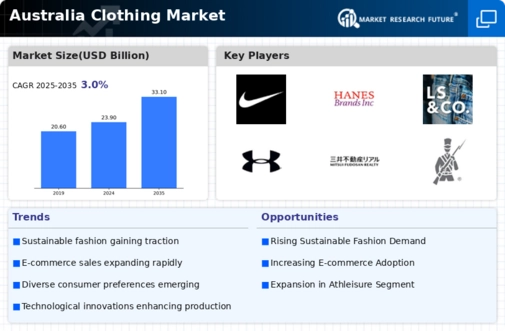Rise of E-commerce
The rise of e-commerce significantly influences the Global Australia Clothing Market Industry, as online shopping becomes increasingly popular among consumers. The convenience of purchasing clothing online, coupled with the availability of diverse brands and styles, has led to a shift in shopping habits. In 2024, the online segment is expected to account for a substantial portion of the market, contributing to the overall valuation of 23.9 USD Billion. Retailers are investing in digital marketing strategies and user-friendly websites to enhance the online shopping experience. This trend is likely to continue, potentially driving further growth in the industry as more consumers embrace the convenience of e-commerce.
Growing Consumer Demand
The Global Australia Clothing Market Industry experiences a notable increase in consumer demand, driven by evolving fashion trends and a rising interest in sustainable clothing. In 2024, the market is valued at approximately 23.9 USD Billion, reflecting a shift towards eco-friendly materials and ethical production practices. This trend is particularly evident among younger consumers who prioritize sustainability in their purchasing decisions. Retailers are responding by expanding their offerings of sustainable apparel, which may further enhance market growth. As consumer preferences continue to evolve, the industry is likely to adapt, potentially leading to increased market share for brands that align with these values.
Market Growth Projections
The Global Australia Clothing Market Industry is poised for substantial growth, with projections indicating a market value of 33.1 USD Billion by 2035. This growth trajectory is supported by various factors, including increasing consumer demand, technological advancements, and the rise of e-commerce. The industry is expected to experience a CAGR of 3.0% from 2025 to 2035, reflecting a steady expansion in market opportunities. As brands adapt to changing consumer preferences and invest in innovative practices, the market is likely to evolve, presenting new avenues for growth and development in the coming years.
Sustainability Initiatives
Sustainability initiatives are becoming increasingly prominent within the Global Australia Clothing Market Industry. As consumers become more environmentally conscious, brands are compelled to adopt sustainable practices, such as using organic materials and reducing waste. This shift not only aligns with consumer values but also enhances brand loyalty. Companies that prioritize sustainability may experience a competitive advantage in the market. The growing emphasis on eco-friendly practices is expected to contribute to the industry's growth trajectory, potentially supporting the anticipated CAGR of 3.0% from 2025 to 2035. This trend reflects a broader global movement towards sustainability in fashion.
Technological Advancements
Technological advancements play a crucial role in shaping the Global Australia Clothing Market Industry. Innovations in manufacturing processes, such as 3D printing and automated production lines, enhance efficiency and reduce costs. These technologies enable brands to respond more swiftly to changing consumer preferences, thus fostering a more dynamic market environment. Additionally, the integration of e-commerce platforms has transformed the retail landscape, allowing consumers to access a wider range of products. As these technologies continue to evolve, they may drive further growth in the industry, potentially contributing to the projected CAGR of 3.0% from 2025 to 2035.
Cultural Influences and Diversity
Cultural influences and diversity significantly shape the Global Australia Clothing Market Industry. Australia’s multicultural society fosters a rich tapestry of fashion styles, which encourages brands to cater to a wide range of consumer preferences. This diversity is reflected in the increasing popularity of ethnic and culturally inspired clothing lines. As brands embrace inclusivity and representation, they may capture a broader audience, thereby enhancing their market presence. The industry is likely to see continued growth as it adapts to these cultural dynamics, potentially contributing to the projected market value of 33.1 USD Billion by 2035.

















Leave a Comment